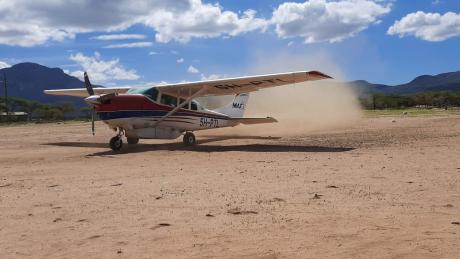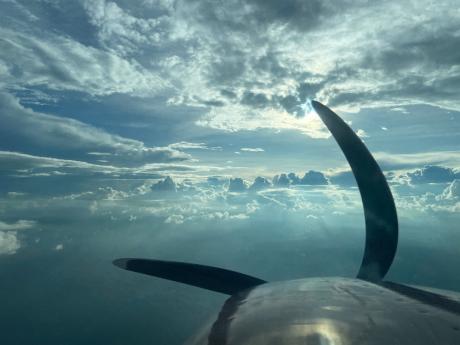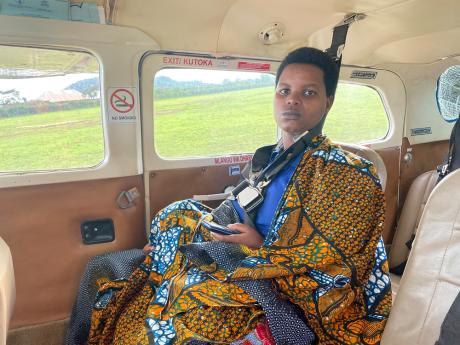
These are the two pictures that tell a heart-breaking story of joy, hope and unbearable grief for women in remote areas of Tanzania.

MAF was called to fly two mothers from Haydom Hospital because they needed specialist care after giving birth to babies with gastroschisis – a rare condition that means the child is born with intestines showing outside of the stomach.
The unusual incident was made all the more remarkable because, by the time MAF pilots Peter Griffin and Mark Liprini arrived at Haydom Hospital, a third mother had given birth to a baby with similar complications.
Aware of the urgency needed to bring the mothers and babies to Kilimanjaro Hospital at Moshi, the pilots had to recalculate quickly to ensure they could fly the additional passengers.
It also meant nine people could be legitimately carried on the six-seater MAF plane for this unusual triple medevac.
“The ambulance came careering back along the rough dirt roads with four adults ... three mothers with babies and an accompanying nurse,” said Mark Liprini.
“We briefly discussed some options, carefully strapped the moms and babies in, and got airborne for Kilimanjaro airport.
“The C206 that we fly has only six seats, but air law allows for newborn infants to be carried on laps.”
The ambulance came careering back along the rough dirt roads with four adults ... three mothers with babies and an accompanying nurse.
MAF works closely with Haydom Lutheran Hospital, which is 300km away from the base in Arusha. The hospital provides access to health care for more than 900,000 people in its catchment area, and 5.7 million people in the greater reference area.
The seriousness of the babies’ condition meant the team at Haydom needed to refer them to the Kilimanjaro Christian Medical Centre (KCMC).
While approximately 90% of infants born with gastroschisis in developed nations survive, there is still a 10% mortality rate due to complications or related defects and infections. In nations without access to the same levels of medical care, the mortality rate is often 100%.
Nurse Bertha said Haydom Hospital sees about ten such cases a year. She flew with the mothers and babies to provide care during flight and said the transfer with MAF was important.

The one-and-a-half hour MAF flight from Haydom, in Tanzania’s Manyara region, spared the mothers and new-borns a bumpy seven- or eight-hour road journey during Tanzania’s rainy season. Instead, they had just a one-hour drive on better roads, after landing at Kilimanjaro International Airport near Arusha, to reach KCMC at Moshi.
“For me, it was my first day to fly with the aeroplane,” said Bertha. “I didn’t get any complications during our transport.”
Bertha took care of the patients all the way through their journey to KCMC but despite the skill and professionalism of the team at the hospital, none of the babies survived.
“I went with the mothers to KCMC. Unfortunately, two of the babies later died,” she added.
“Two of the babies had gastroschisis and the other had another abdominal condition called atresia (a blockage of the intestines).”

Heartbreakingly, Rose developed complications which claimed her short life. Victoria left KCMC with her child’s body in her arms for the drive to Arusha where she caught another MAF flight back to Haydom with MAF pilot Peter Griffin.
Peter recalled the mothers’ initial feelings on the first medevac flight and the deep sadness as Victoria returned to her community.
“They seemed a bit nervous, I don’t think any of them had been in an aircraft before, so it was a first time for all of them,” Peter said.
“The mothers were fairly young women, I was very careful to help them with their seatbelts, to be careful with their babies.
The medevacs are the thing we hold most dear.
“We flew them directly to Kilimanjaro International, which was the closest airport available.
“I think that is the essence of why we do what we do, that I feel is the calling I am here for. We do medical safaris, we do clinics, which are very important and have a big impact.
“But the medevacs are the thing we hold most dear. They are the things that I as a pilot feel like we will go around any mountain we need to, to get it done.
“We are doing the help and the hope, and the doctors do the healing part. We can give the healing of God, through our faith, but there’s only so much we can do in that area. We can do the other two parts especially with these kinds of flights and that is our responsibility as Christians that we do all we can, and we should.”
MAF’s Ground Operations Manager in Tanzania, Emmanuel Mollel, said programme staff had been determined to respond quickly to Haydom Hospital’s initial call for a medevac.
“It was a different kind of call,” Emmanuel said. “Everyone in Haydom was excited to hear that we could fly the patients to Kilimanjaro, but I felt sorry when I discovered that the patients in need of the medevac flight were new-born babies.
“You always want to help those who need a quick medical evacuation but this time round it was different.”